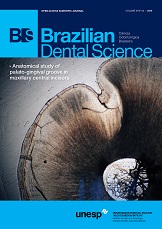Anatomical study of palato-gingival groove in maxillary central incisors
DOI:
https://doi.org/10.14295/bds.2015.v18i3.1133Resumo
Palatogingival groove (PGG) is a developmental anomaly affecting mainly the maxillary incisors. PGG incidence, depth, and length are clinically important because it may cause severe and localized periodontitis; and it may divide the root canal resulting in accessory foramina. This study aimed
to analyze the presence, shape, length, and depth of the palatogingival groove in maxillary central incisors. 1,668 maxillary central incisors were
used. Each tooth had its root portion inspected in order to verify PGG presence and depth. The found palatogingival grooves were classified according to the system proposed by Gu [5], as follows: Type I (short and superficial), Type II (long and superficial), and Type III (long and deep). All teeth that showed the grooves were radiographed; five teeth had their
root surface analyzed through Scanning Electron Microscopic (SEM); and four teeth corresponding to each PGG type were sent to obtain histological
sections and then submitted to microscopic analysis. Of the 1.668 analyzed incisors, 27 (1.61%) showed the palatogingival groove: 8 (29.6%) Type I, 17 (63%) type II, and 2 (7.4%) Type III. Microscopic analysis revealed no communication between PGG and root canal. In conclusion, our results showed that PGG can be clinically and radiographically diagnosed on maxillary central incisors, with the type II being the most common. The professionals
should be aware of the features of this groove due to its severe clinical consequences.
KEYWORDS
Incisor; Anatomical variation; Palatogingival groove
Downloads
Downloads
Publicado
Como Citar
Edição
Seção
Licença
TRANSFERÊNCIA DE DIREITOS AUTORAIS E DECLARAÇÃO DE RESPONSABILIDADE
Toda a propriedade de direitos autorais do artigo "____________________________________________________________________" é transferido do autor(es) para a CIÊNCIA ODONTOLÓGICA BRASILEIRA, no caso do trabalho ser publicado. O artigo não foi publicado em outro lugar e não foi submetido simultaneamente para publicação em outra revista.
Vimos por meio deste, atestar que trabalho é original e não apresenta dados manipulados, fraude ou plágio. Fizemos contribuição científica significativa para o estudo e estamos cientes dos dados apresentados e de acordo com a versão final do artigo. Assumimos total responsabilidade pelos aspectos éticos do estudo.
Este texto deve ser impresso e assinado por todos os autores. A versão digitalizada deverá ser apresentada como arquivo suplementar durante o processo de submissão.




























